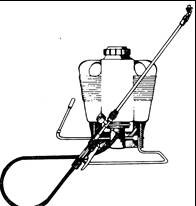There are several ways to apply disinfectants. The most frequently systems used are:
Clean-in-Place Systems
Clean-in-place systems are used for internal disinfections of a plant or equipment. The disinfectant is generally sprayed on equipment using a standard spraying knapsack applicator or a hand pump. The disinfectant is diluted with water (check the label for the correct dosage) and the area to be disinfected is simply sprayed. In most cases, the area is sprayed to the point of run-off (wet). It may however be necessary to apply a specific dosage rate per unit area. In such cases ensure that the equipment is calibrated.
Knapsack sprayers consist of a tank with a capacity of up to 20 l.
The tank forms the main body of the sprayer and is usually carried on the back. Inside the tank is a cylinder with an open-and-shut valve causing the building up of pressure once the handle on the side is manoeuvred up-and-down. Pressing the trigger on the application system allows the contents (under pressure) to escape the tank through nozzles at the tip of the system. These nozzles can be adjusted to suit your application requirements.

Mist Spraying
Mist spraying indicates the application of a disinfectant in a form of small droplets. Mist applicators change the disinfectant solution into an aerosol that is dispersed throughout the area being treated. Usually, the solution is applied as Ultra-Low Volume; similar to that in ULV pesticide applicators, and therefore the solution being applied is highly concentrated. Suitable personal protective equipment such as boots, coveralls, gloves and respiratory protective equipment must be worn. Ensure that the respirators are fitted with the correct filter types. It is imperative that operators take the necessary preventative health steps.

Fogging
Fogging produces smaller droplets than mist sprayers. Typically, foggers will create a “fog” of highly concentrated disinfectant solution. Because of the small droplets being created the residue time of the solution is normally longer than in the case of misters and sprayers, therefore the prohibiting time for entering that area should be strictly adhered to.
There are two main types of foggers that are generally used, namely cold or thermal foggers. Cold fogger units produce a cleaner fog or mist than other applicators and can be used either indoors or outdoors. These applicators can dispense both water or oil-based chemical formulations.

Thermal foggers are powered by electricity or gas-driven to generate heat that turns the chemical into the fog. This fog fills the whole room, meaning that it comes into contact with all surfaces, top to bottom.

Manual Disinfection and Mopping
Click here to view a video that explains farm cleaning disinfecting.
Manual disinfection and mopping is probably the simplest way to apply disinfectants. In this system, a cloth, brush or mop is used to apply the disinfectant solution from a bucket. This is normally the most time-consuming system and not always effective as it may be difficult to get the solution into small crevices and corners. It is however more effective applied after an area was thoroughly cleaned. It is possible to apply disinfectant whilst cleaning and area. It is wise to wear an impermeable apron, overalls, gloves/gauntlets and safety spectacles/visor. Wear respiratory protection when working in enclosed spaces.
Although the application of a disinfectant is more relevant to storage and packing facilities, knowledge becomes relevant to the farming system, especially where crops are produced in greenhouses and tunnels as they require regular disinfecting between cropping periods. It is also critical that disinfectant trays are placed at the entrances of the facilities. The idea is that one walks through the tray containing a disinfectant (usually a chlorine-based solution) before entering the greenhouse/tunnel to prevent micro-organisms from entering the facility and possibly attacking the crop.